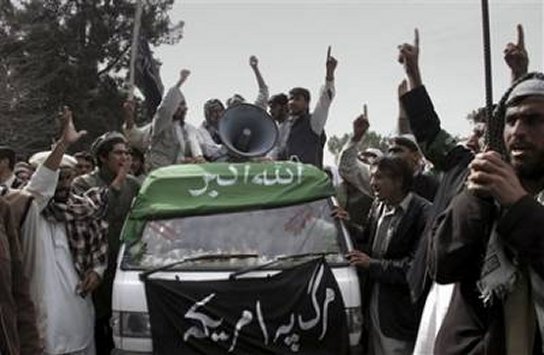
Afghans shout slogans against the U.S. and Afghan governments as the green banner on the vehicle says’ Allah is great’ and the black banner says ‘down with America’ during a demonstration in Jalalabad, the provincial capital of Ningarhar province,, east of Kabul, Afghanistan, on Monday, March 2, 2009
U.S. Commander Decries ‘Barbaric’ Enemy Actions in Afghanistan
Story by Gerry Gilmore
Insurgents in Afghanistan employ intimidation and barbaric acts in attempts to cow Afghan civilians to submit to their will or stay nonaligned in the struggle for the country, a senior U.S. military officer posted in Afghanistan said today.
For example, insurgents routinely place threatening letters onto the exteriors of schools and government buildings during the night, Army Col. John P. Johnson, commander of Combined Task Force Currahee, told Pentagon reporters during a satellite-carried news conference.
Johnson’s task force, centered on the 506th Infantry Regiment of the 101st Airborne Division’s 4th Brigade Combat Team, from Fort Campbell, Ky., has been in Afghanistan nearly a year. His headquarters is at Forward Operating Base Salerno in Khowst province. The command covers an area about the size of Maryland and is responsible for activities in Paktia and Paktika provinces, as well.
Insurgents in his area “act in a ruthless and barbaric manner,” Johnson said. During a recent incident in eastern Paktika province, he recalled, insurgents murdered three tribal elders after they’d attended a meeting with Afghan and coalition officials.
The insurgents showed up several days later and “essentially decapitated” the three elders, Johnson said, and then burned their bodies atop a pile of coalition-provided humanitarian goods that was set afire.
“It just demonstrates the viciousness, ruthlessness, a lack of humanity that [the insurgents] can use to intimidate a population,” Johnson said. “This is a country that very much is run in large sense by the rumors that are generated through the population.”
News or rumors of insurgent outrages travel to cities and villages, Johnson said.
“So, it’s a very strong and ruthless form of intimidation” that’s practiced by the insurgents, Johnson said.
“They don’t just make idle threats, they actually carry them out in a barbaric fashion,” the colonel said.
Insurgent violence has made some villagers afraid to cooperate with Afghan and coalition officials, Johnson said.
However, he said, increased voter registration in his area of operations indicates how Afghan civilians “really stand in terms of wanting to preserve a right to vote [and] for some representative system that can provide a better way ahead.”
Meanwhile, U.S., coalition and Afghan authorities are working together to confront insurgent propaganda, intimidation and violence, Johnson said.
“We certainly maximize the utility of the airwaves,” Johnson said. “Radio is very much a strong form of communication that we use. The enemy also uses it in a much lesser form.”
Afghan government and security leaders “get on these radios and they talk directly to the people,” Johnson explained. The biggest task for the Afghan’s anti-insurgent information program, he said, seems to be finding a cohesive message that resonates from the national to local levels of Afghan society.
“We continue to work on that. We continue to improve oral communication with our Afghan partners,” Johnson said. “But, that’s critical, I think, to get that message right, from the village all the way up to the national level.”
Afghan security forces are stepping up to confront the insurgents, Johnson said. He praised the contributions of the Afghan army’s 203rd Corps, which he said has developed the ability to plan and conduct simultaneous and nearly independent brigade-sized operations in the past year.
“What threatens the enemy the most this year is the increased capability and capacity of the Afghan national security forces,” Johnson said. The Afghan army, he said, is “the backbone of this effort” and is making a difference in the anti-insurgent campaign.
Johnson’s command is a mountainous region that’s part of the U.S.-led Regional Command-East. His task force once had responsibility for six Afghan provinces. All three of the provinces now under Johnson’s purview are along the Pakistan border.
A Polish task force took over responsibility for Ghazni province in November, Johnson said, while an infantry brigade combat team from the U.S. Army’s 10th Mountain Division has overseen activities in Lowgar and Wardak provinces since last month.
Most enemy fighters in his area, Johnson said, are not native Afghans, but rather foreigners that cross over from Pakistan. Enemy attacks have increased in his sector by about 20 percent from a year ago, he estimated.
“We do not see platoons [of insurgents] drawn from the local population to conduct major attacks,” Johnson said. “To me, this reflects a lack of willingness within the population to actively support the enemy’s efforts and the importance of external support for them to achieve their goals.”
The presence of foreign fighters in Afghanistan highlights the importance of improving security along the Afghanistan-Pakistan border, Johnson said.
“Our effort to build up the Afghan border police is essential to our success here,” Johnson said.
Reconstruction and humanitarian efforts continue throughout his sector, Johnson said, citing the ongoing construction of the Khowst-to-Gardez highway. When completed, the road will connect Khowst to the interior of Afghanistan and bring “much-needed services and security to a very important population,” he said.
Meanwhile, Johnson said, it’s imperative to “improve our ability to properly communicate the true nature of this enemy to a population bombarded by a relatively effective [enemy] propaganda campaign, and more importantly, an intimidation campaign.”

Wild Thing’s comment…….
For example, insurgents routinely place threatening letters onto the exteriors of schools and government buildings during the night,
I bet our snipers with night scopes are going after these people. But let’s not tell Obama, he would not like it if his “moderate” Taliban were being killed. sheesh I can’t believe he even had that thought enter his brain. OH wait it is HIS brain so yes, it would think like that, from one Muslim with a friend that is a terrorist ( Bill Ayers) to another terrorist in Afghanistan.

Of course Obama understands the Taliban. The are just like Chicago politics. Only the level of thuggary is different and even that may be debatable.
I thought these people were going to love us again, once a deficrat was elected, hmmm, maybe hillary can take her magic button over there and do some tricks for those half-lifes.
When are these morons going to realize it doesn’t matter whose in the white house or has control of congress, If the U.S. isn’t passing out money they hate us. That’s what obama’s trying to do for the Palestinians, bribe them.
Tom, your right, there sure aere a lot of similarities between the far left or the thugs and the Taliban.
Mark, I thoguht so too, I really did, I thought they would feel a brotherhood of sorts with Obama. hahaha I sure was wrong.